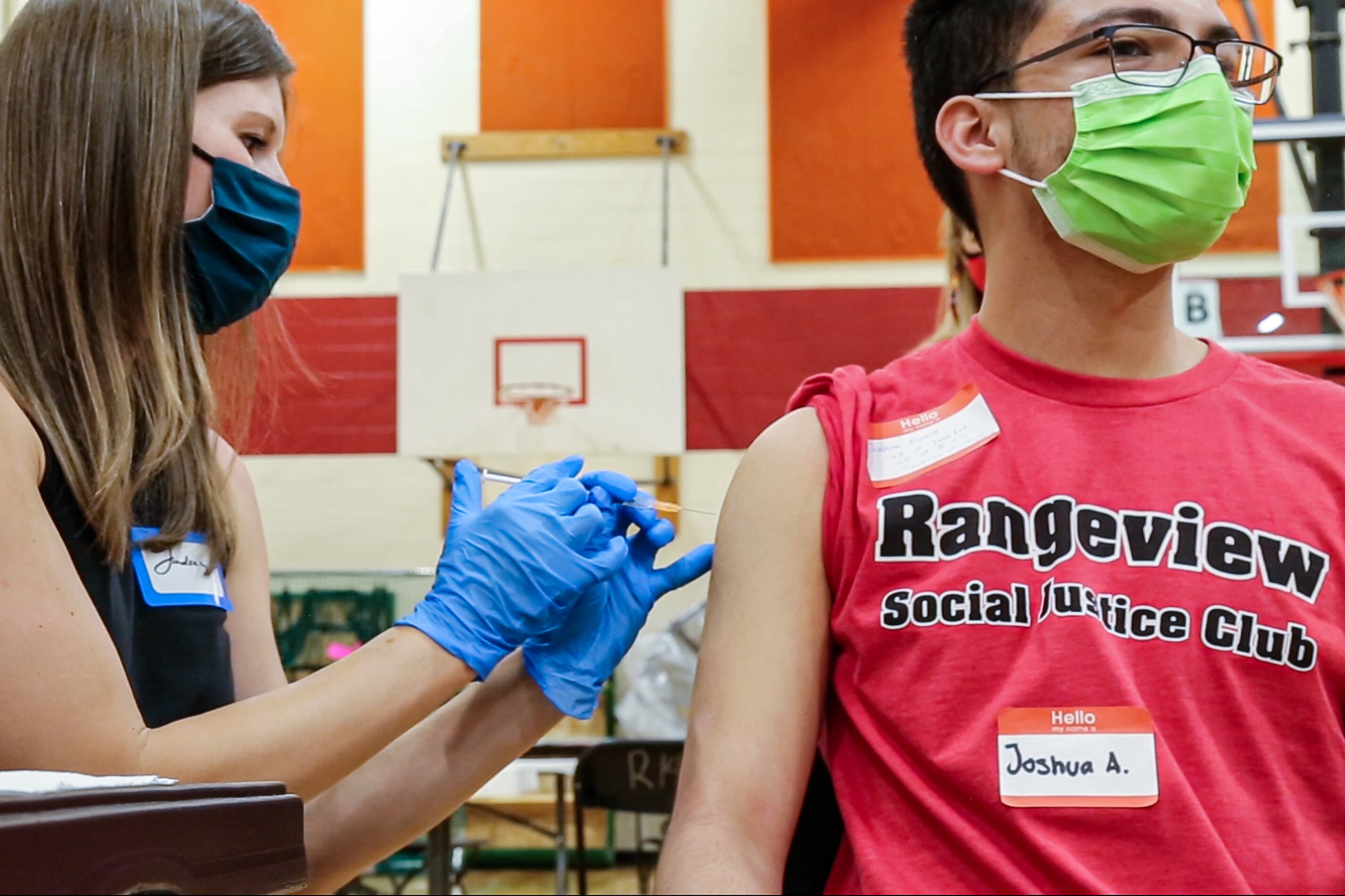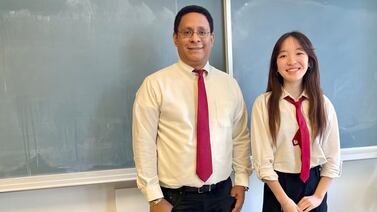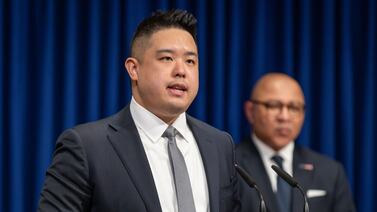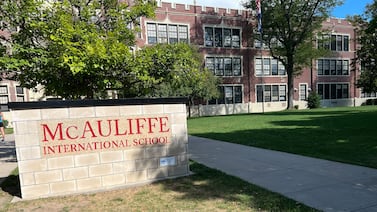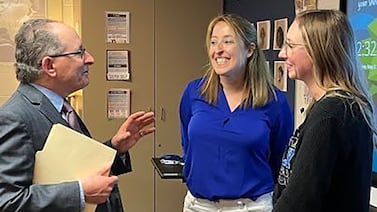When the Social Justice Club at Aurora’s Rangeview High School held a COVID-19 vaccine clinic for fellow students earlier this month, half of the 422 people who lined up for shots were teenagers taking advantage of their new eligibility and hoping to get back a portion of their normal lives.
Of the rest, many were family members whose children helped them overcome whatever barrier was holding them back.
“Having the clinic at Rangeview establishes that sense of trust,” said Yeabsera Fitsum, a junior and member of the club. “It’s happening in a place we all know and love.”
This week, the federal Centers for Disease Control opened vaccine eligibility to children aged 12 to 15, clearing the way for most middle and high school students to get vaccinated against COVID-19. Children in that age group drove an increase in cases in April and a corresponding increase in school outbreaks and quarantines. Getting more children vaccinated is the key to more normal schooling and more normal social lives, school officials and doctors said.
“We are seeing an increase in students testing positive and most of our quarantines are due to students testing positive,” said Theresa Myers, a spokesperson for the Greeley-Evans school district. “We’re hoping in the fall that we have more students vaccinated so we can reduce those disruptions.”
As of Thursday, eligible children can get vaccinated anywhere that offers the Pfizer vaccine, though they do need parental permission. Polls have found that from 30% to 50% of parents plan to get their children vaccinated as soon as possible, but others are more cautious. So far, K-12 schools are not requiring the vaccine, though a growing number of colleges and universities are.
In the final weeks of a disrupted school year, some districts are partnering with health care providers and community groups to run clinics especially for students.
Denver Public Schools has partnered with Denver Health to offer the vaccine at its 18 school-based health centers. Jeffco Public Schools vaccinated more than 1,100 students at a recent drive-up clinic and plans to offer several more. For some students, their second shot falls on graduation day.
Greeley-Evans helped vaccinate 900 students through a partnership with Sunrise Health and is working with the Latino Coalition of Weld County to set up more school-based clinics.
“We are going to try aggressively to get most of this done before the students get out,” said Deb Suniga, deputy director of the state Latino COIVD Equity Task Force and public relations director for the Latino Coalition of Weld County. The coalition is working with school districts and community groups across northern Colorado.
The Roaring Fork School district ran clinics at its high schools and plans to offer middle school clinics soon. Teachers there prepared a lesson that helps students understand vaccine science and address common myths, something teachers at Rangeview also did.
Vaccines are much more widely available now than earlier in the year, and more doctor’s offices could start stocking COVID vaccines this summer. Some districts are sending information about community-based vaccination opportunities to families rather than organizing their own clinics.
But school-based health centers and pop-up clinics at schools have a number of advantages. Many parents see schools as trusted locations where adults care for their children. On a more practical level, they know where to go and where to park. Opening vaccination to teenagers has also had the unexpected but welcome side effect of drawing in their relatives.
“We have had really good success in bringing in kids and getting their families vaccinated at the same time,” said Dr. Sonja O’Leary, a pediatrician and medical director of Denver Health’s school-based health centers. “We saw a dad who was coaxed by the kids. We even vaccinated an 83-year-old grandma. The kids make the decision that this is the right thing for them to do, and then they bring the family along.”
That was the experience of Joshua Alvarez, another member of the Social Justice Club at Rangeview. His aunt, an immigrant from Ecuador, wasn’t sure she wanted the vaccine, until she saw that he was also getting it.
“I told her we were doing it at Rangeview and that I was doing it and my cousin was doing it and she might as well too. It eased her into saying, ‘I’ll just get vaccinated,’” he said.
Similarly, Yeabsera said getting vaccinated opened the door to conversations with older relatives from Ethiopia, who got to ask her all their questions in their native language.
Some of their peers also have questions about the vaccine’s safety and track record. The most common question, Joshua said, was whether we can be sure the vaccine is safe given how quickly it was developed. He points out that vaccine development involved some of the world’s top scientists working together in an unprecedented effort.
O’Leary also hears this question from parents. She explains that mRNA technology has been around for years and applied to other vaccines. She’s been thrilled to offer the vaccine after a year in which children have lost so much.
“The impact on children has been devastating in terms of increased chronic absenteeism, worsening mental health, and their educational attainment,” she said. “For me, to be able to vaccinate anyone 12 and older, it’s very exciting in terms of being able to bring everyone back together. It’s a game changer.”
Dr. Sean O’Leary, a pediatrician at Children’s Hospital Colorado and vice president of the Committee on Infectious Diseases for the American Academy of Pediatrics (and Sonja O’Leary’s husband), said some people wonder why children should get vaccinated, if they’re at lower risk.
There are a lot of reasons, he said, from keeping community transmission low to returning to regular social activities and avoiding quarantine.
But the most important is children’s own health. Even with masking, quarantines, and school closures, more children have died of COVID than die of flu in a typical year, he said.
“It is more serious in older adults, but it is incorrect to say it is benign in children,” O’Leary said. “We have taken care of plenty of very sick kids and unfortunately had some deaths.”
Parents who have questions about vaccine safety might feel more comfortable getting the vaccine from their regular doctor, Sean O’Leary said.
For now, the Pfizer vaccine, with its strict cold storage requirements, is the only vaccine approved for people younger than 18. Pfizer ships in large packs of 1,170 doses, and the clock starts ticking once it moves out of cold storage. That presents some challenges to offering the vaccine in a doctor’s office that would administer far fewer doses a week than a dedicated clinic, O’Leary said, but state health officials and vaccine manufacturers are actively working on solutions.
The cold storage requirements also present challenges in rural parts of the state. San Miguel County includes affluent communities like Telluride but lacks many of the health care resources that Front Range communities enjoy.
“To date, we’ve really struggled to get supplies and have clinics,” San Miguel Public Health Director Grace Franklin said. “It was made very clear that Pfizer was not going to be on the table.”
When eligibility opened to older teenagers, 35 of them drove two hours one way to get the Pfizer shot at Southwest Memorial Hospital in Cortez. By pre-registering interested teenagers, San Miguel has been able to run two local clinics by bringing Pfizer doses in by courier. Younger teenagers — 60 have already pre-registered — will get their first shot at the same clinic where older teenagers get their second later in May.
In Telluride, public health workers ran the clinic in the gym of the intermediate school, but in the more conservative ranching community of Norwood, they had to move the clinic to the library after parents raised concerns that children would be vaccinated without parental consent.
That would never happen, Franklin said. In retrospect, she wishes the notice had read “we will be offering,” rather than “we will be administering,” the COVID-19 vaccine, a lesson learned.
Six teenagers out of 30 eligible got the shot at the library. Franklin counted it a win.
Chalkbeat reporter Yesenia Robles contributed to this report.


